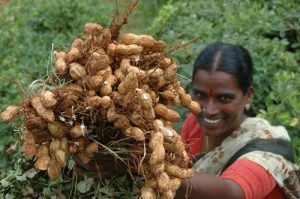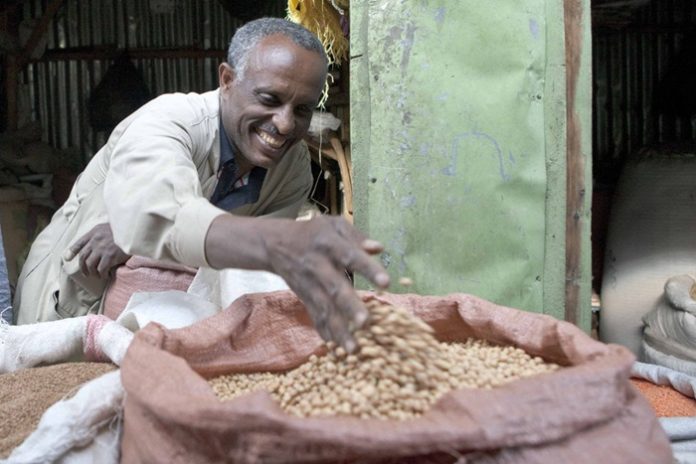Researchers at the International Crops Research Institute for the Semi-Arid Tropics (ICRISAT) are leading a transformation in crop testing, combining AI-driven models and pocket-size near-infrared spectroscopy (NIRS) devices. These portable sensors allow for quick evaluation of nutrition levels in indigenous food grains right at the farmer’s gate or in research fields.
Director general of ICRISAT, Jacqueline d’Arros Hughes, championed the integration of this disruptive technology into breeding pipelines and key points of relevant value chains. Aligned with the UN Food and Agriculture Organization (FAO) strategy, Hughes foresees the tool as a catalyst for the production of nutrient-dense crops, both in breeding programs and in farmers’ fields, a crucial element in the global fight against malnutrition.
“This technology is poised to expedite the breeding of nutrient-dense crops while facilitating their integration into the value chain. Our goal with this intervention is to provide quality assurance for the distribution of nutritionally fortified crops, so that they reach those who need them most,” remarked Hughes.
Traditionally, assessing the nutritional quality of grains and feedstock could take a number of weeks, involving manual or partially automated processes and laboratory instruments. In contrast, mobile NIRS devices are more cost-effective and can assess over 150 samples per day per person.
These non-destructive and robust grain quality measuring devices provide timely information on grain composition and can be used to promote quality-based payments in the market—benefiting food producers, grain processing industries, and farmers alike.
“We see the adoption of portable technology for assessing grain quality as an important step in decentralizing and democratizing market systems, essential to promote the consumption of nutri-cereals. This transition can facilitate quality-driven payments for farmers, while providing quality assurance to health-conscious households moving forward,” noted Sean Mayes, global research director of the accelerated crop improvement program at ICRISAT.
Boosting nutrition in peanut breeding and introducing quality-based payments into the value chain
In Anantapur, India, ICRISAT recommends its Girnar 4 groundnut variety to ensure premium prices for farmers and to differentiate the crop from lower-value varieties.

ICRISAT’s Girnar 4 and Girnar 5 groundnut varieties boast oleic acid levels of 75-80%, far surpassing that of the standard variety at 40-50%. Oleic acid is a heart-healthy monounsaturated fatty acid, which holds considerable importance for the groundnut market, as it provides new end-uses for the crop.
Growing consumer awareness of its advantages spurred market demand for high oleic acid content in oils and related products. This pioneering approach, initially applied in peanut breeding, could be replicated across other crops, offering efficient and cost-effective solutions to address poor nutrition.
ICRISAT’s Facility for Exploratory Research on Nutrition (FERN laboratory) is expanding its prediction models to encompass various traits and crops beyond groundnuts.
“We are currently focusing on developing methods to assess oil, oleic acid, linoleic acid, carotenoids, starch, moisture, and phosphorus in various cereals and legumes, such as finger millet, foxtail millet, pearl millet, sorghum, maize, wheat, chickpea, mungbean, common bean, pigeonpea, cowpea, soybean, groundnut, and mustard,” shared Jana Kholova, cluster leader of Crop Physiology and Modelling, ICRISAT.
IndiFoodBev — authentic, impactful and influential
An English-language food and beverage processing and packaging industry B2B platform in print and web, IndiFoodBev is in its third year of publication. It is said that the Indian food and beverage industries represent approximately US$ 900 billion in revenues which implies more than 20% of the country’s GDP. Eliminating the wastage on the farmside can help to deliver more protein to a higher number of the population apart from generating sizable exports. The savings in soil, seeds, water, fertilizer, energy and ultimately food and nutrition could be the most immense contribution that country is poised to make to the moderation of climate change.
To improve your marketing and grow sales to the food and beverage processing and packaging industry, talk to us. Our research and consulting company IppStar [www.ippstar.org] can assess your potential and addressable markets in light of the competition. We can discuss marketing, communication, and sales strategies for market entry and growth.
Suppliers and service providers with a strategy and budget for targeted marketing can discuss using our hybrid print, web, video, and social media channels to create brand recognition linked to market relevance. Our technical writers are ready to meet you and your customers for content.
The second largest producer of fruit and vegetables in the world is continuously expanding processing capacities and delivery systems with appropriate innovative technologies. We cover product and consumer trends, nutrition, processing, research, equipment and packaging from farm to thali. Get our 2025 media kit and recalibrate your role in this dynamic market. Enhance your visibility and relevance to existing markets and turn potential customers into conversations. Ask for a sample copy of our bi-monthly in print or our weekly IndiFoodBev eZine each Wednesday.
For editorial info@ippgroup.in — for advertisement ads1@ippgroup.in and for subscriptions subscription@ippgroup.in
Naresh Khanna – 10 February 2025
Subscribe Now











